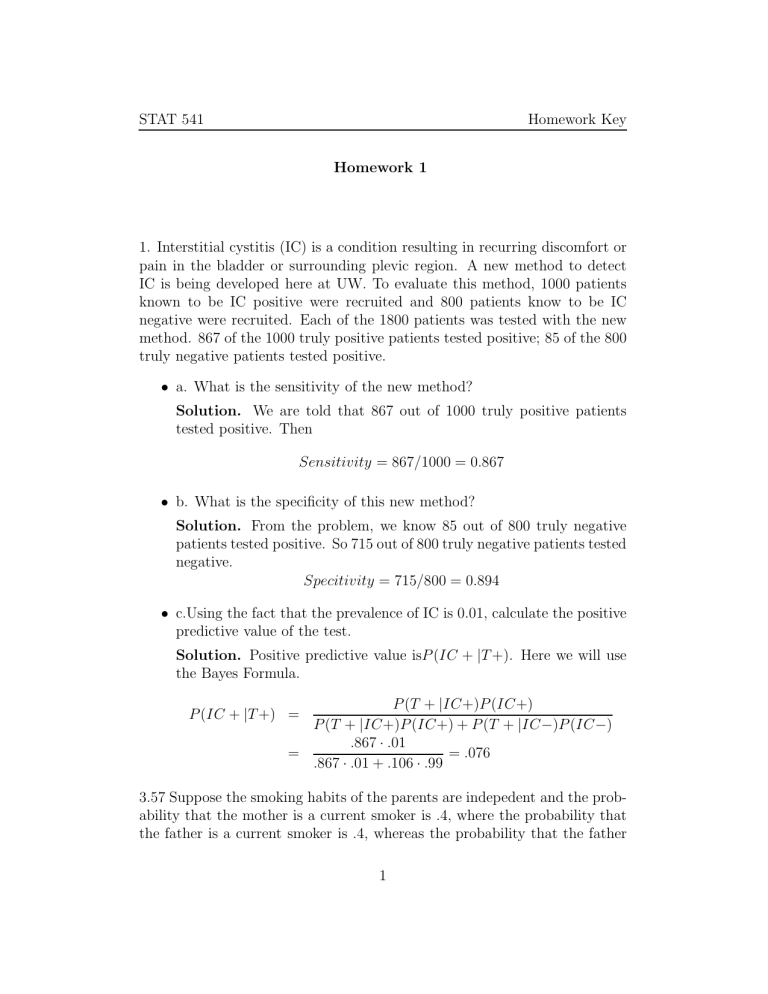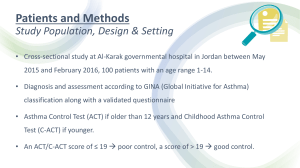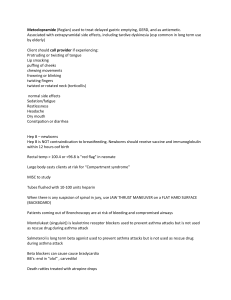
STAT 541 Homework Key Homework 1 1. Interstitial cystitis (IC) is a condition resulting in recurring discomfort or pain in the bladder or surrounding plevic region. A new method to detect IC is being developed here at UW. To evaluate this method, 1000 patients known to be IC positive were recruited and 800 patients know to be IC negative were recruited. Each of the 1800 patients was tested with the new method. 867 of the 1000 truly positive patients tested positive; 85 of the 800 truly negative patients tested positive. • a. What is the sensitivity of the new method? Solution. We are told that 867 out of 1000 truly positive patients tested positive. Then Sensitivity = 867/1000 = 0.867 • b. What is the specificity of this new method? Solution. From the problem, we know 85 out of 800 truly negative patients tested positive. So 715 out of 800 truly negative patients tested negative. Specitivity = 715/800 = 0.894 • c.Using the fact that the prevalence of IC is 0.01, calculate the positive predictive value of the test. Solution. Positive predictive value isP (IC + |T +). Here we will use the Bayes Formula. P (T + |IC+)P (IC+) P (T + |IC+)P (IC+) + P (T + |IC−)P (IC−) .867 · .01 = .076 = .867 · .01 + .106 · .99 P (IC + |T +) = 3.57 Suppose the smoking habits of the parents are indepedent and the probability that the mother is a current smoker is .4, where the probability that the father is a current smoker is .4, whereas the probability that the father 1 STAT 541 Homework Key is a current smoker is .5. What is the probability that both the father and mother are current smokers? Solution. From the propertities of independent events, we know P(F+ and M+)=P(F+)P(M+)=.5 · .4=.2 (F+: The event of father smokes) 3.58 Consider the subgroup of families where the mother is not a current smoker. What is the probability that the father is a current smoker among such families? How does this probability differ from that calculated in Problem 3.57? Solution. Here the probability is actually P (F + |M−). Since the habits of the parents are independent, P (F + |M−) = P (F +) = .5. 3.59 If the probability that the father is a current smoker is .5, what is the probability that the father is a current smoker and the mother is not a current smoker? Solution. From 3.59, we don’t have the independent assumptions any more. But we have the conditional probability to help us! P(F+ and M-)=P (M − |F +)P(F+)=[1 − P (M + |F +)]P(F+)=[1 − .6] · .5=.2 3.60 Are the current smoking habits of the father and the mother independent? Why or why not? Solution. First, we already know P (M + |F +)=.6 andP (M + |F −)=.2. Since P (M + |F +) 6= P (M + |F −), their current smoking habits are not independent. 3.61 Under the assumptions in Problem 3.59 and 3.60, find the unconditional probability that the offspring will have asthma. Solution. What we want to get is directly P(asthma) and conditional probabilities can help us to solve it. P (asthma) = P (asthma and F + M+) + P (asthma and F + M−) + P (asthma and F − M+) + P (asthma and F − M−) = P (asthma|F + M+)P (F + M+) + P (asthma|F + M−)P (F + M−) + P (asthma|F − M+)P (F − M+) + P (asthma|F − M−)P (F − M−) = .15 · P (M + |F +)P (F +) + .05 · P (M − |F +)P (F +) + .13 · P (M + |F −)P (F −) + .04P (M − |F −)P (F −) The probabilities of children have asthma under the condition of the parents are known from the stories before 3.57. AndP (M +|F +)=.6,P (M −|F +)=.4, 2 STAT 541 Homework Key P (M + |F −)=.2, P (M − |F −)=.8, P(F+)=P(F-)=.5. If we plug in all these values, we get the final answer: .084 3.62 Suppose a child has asthma. What is the posterior probability that the father is a current smoker? Solution. From the problem, we know P (F + |asthma) is our goal. By the definition of conditional probabilites, P (F + |asthma)=P(F+ and asthma)/P(asthma). Then we can use the total probability to go on! P (F + and asthma) = P (F +, asthma and M+) + P (F +, asthma and M−) = P (asthma|F + M+)P (F + M+) + P (asthma|F + M−)P (F + M−) Then, since P (asthma|F + M+)=.15 and P (asthma|F + M−)=.05, we only need to work on P(F+M+)and P(F+M-). But these two are already solved in problem 3.61. P (F + M+) = P (M + |F +)P (F +) = .6 · .5 = .3 P (F + M−) = P (M − |F +)P (F +) = .4 · .5 = .2. Finally, we plug in all the probabilities, and get P (F + |asthma)=.655 5.78 If a decline of 2% in bone-mineral density is considered clinically significant, then what percentage of wonmen in the placebo group can be expected to decline at least this much? Solution. From the setting before this problem, we know the change in bone mineral density (Let’s denote it as X) has the normal distribution with mean -1.8% and a standard deviation of 4.3%. What we want to solve is P (X ≤ −2%). First, we want to change X into Z and then use the standard normal distribution table(Table 3 in the back of the textbook) to get the answer. X − (−1.8%) −2% − (−1.8%) ≤ ) 4.3% 4.3% = P (Z ≤ −.05) = P (Z ≥ .05) = .4801 P (X ≤ −2%) = P ( 3 STAT 541 Homework Key So 48.01% of the women in the placebo group will expected to decline at least 2%. 5.79 What percentage of women in the alendronate 5-mg group can be expected to have a clinically significant decline as defined in Prolem 5.78? Solution. For this problem, the variable is different from that in 5.78. From the settings above this problem, we know X(the decline in bone-mineral of women in the alendronate 5-mg group) has a normal distribution with mean 3.5% and standard deviation 4.2%. What we want to solve isP (X ≤ −2%). Using the same ideas as that in 5.78, we have: X − 3.5% −2% − 3.5% ≤ ) 4.2% 4.2% = P (Z ≤ −1.31) = P (Z ≥ 1.31) = .0951 P (X ≤ −2%) = P ( So 9.51% of women in the alendronate 5-mg group can be expected to have a clinically significant decline. 5.80 Suppose 10% of the women assigned to the alendronate 5-mg group are actually not taking their pills (noncompliers). If noncompliers are assumed to have a similar response as women in the placebo group, what percentage of women complying with alendronate 5-mg treatment would be expected to have a clinically significant decline?(Hint: Use the total-probability rule.) Solution.Here, situations are a little complicated.Only 90% of the women who are in the alendronate 5-mg group actually take the pills. This problem asks us to solve P (X ≤ −2%|complying). First, we would use the hint. P (X ≤ −2%) = P (X ≤ −2%|complying)P (complying) + P (X ≤ −2%|not complying)P (not complying) = .9P (X ≤ −2%|complying) + .1P (X ≤ −2%|not complying) From 5.79, we knowP (X ≤ −2%) = .0951. From 5.78, we know P (X ≤ −2%|not complying) = .4801, because the women who don’t take pills are treated as the placebo case. Then, what is unknown is P (X ≤ −2%|complying). So we can solve the equation to get it. P (X ≤ −2%) − .1P (X ≤ −2%|not complying) P (X ≤ −2%|complying) = .9 .0951 − .1 · .4801 = = .0523 .9 4 STAT 541 Homework Key So, 5.23% of women complying with alendronate 5-mg treatment would be expected to have a clinically significant decline. 5.102 What is the probability that compliant type-I diabetic 12-year-old boys will gain at least 15lbs over 1 year? Solution. We want to get P (X ≥ 15) (X: the weight gain over 1 year). This is a simple one comparing with the one above. We only need to transform X to get Z. X − 12 15 − 12 P (X ≥ 15) = P ( √ ≥ √ ) 12 12 = P (Z ≥ .87) = .1922 So, the probability that compliant type-I diabetic 12-year-old boys will gain at least 15lbs over 1 year is .1922. 5.103 Answer the question in Problem 5.102 for non-compliant type-I diabetic 12-year-old boys. Solution. For this one, the method is similar to 5.102. We want to get P (X ≥ 15)(X:the weight gain of noncompliant boys over 1 year ) X −8 15 − 8 P (X ≥ 15) = P ( √ ≥ √ ) 12 12 = P (Z ≥ 2.02) = .0217 So, the probability that noncompliant type-I diabetic 12-year-old boys will gain at least 15lbs over 1 year is .0217. 5





